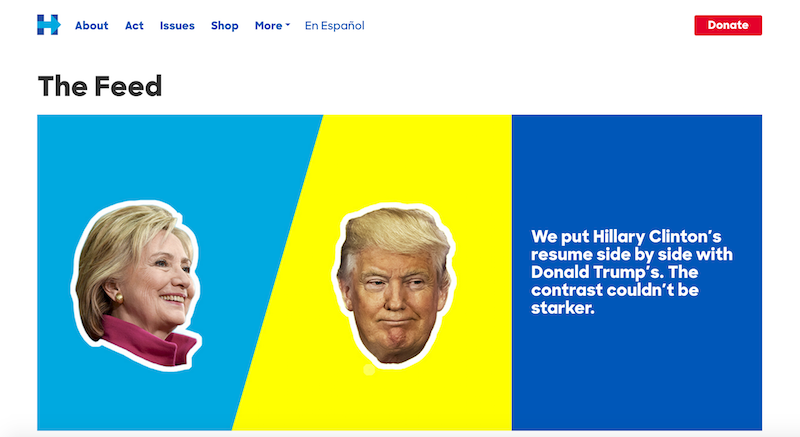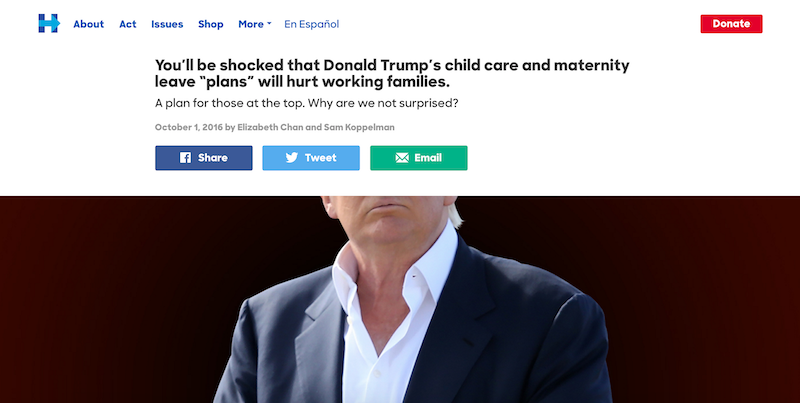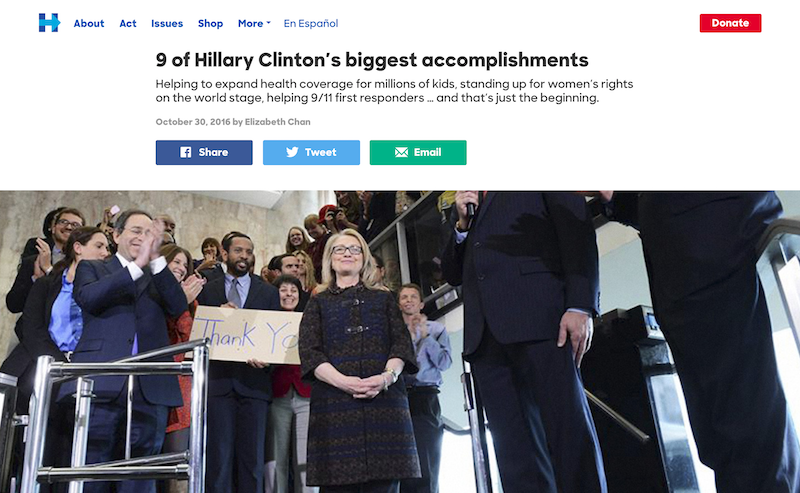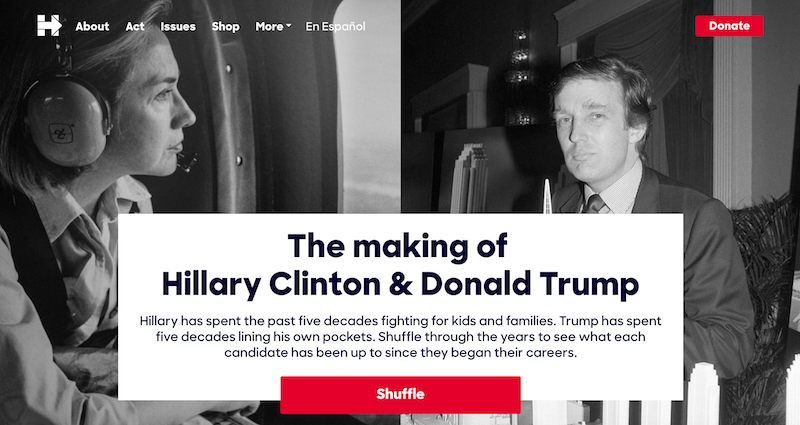|
Getting your Trinity Audio player ready...
|
Presidential election season reliably creates a deluge of political content: articles, infographics, charts, policy analyses, talk show segments, and late night comedy bits.
But as the waters rose for the 2016 election, we weren’t treated to just the usual cadre of big media columnists, satirists, beat reporters, or the now almost humdrum blitz of campaign ads and branding operations.
No, this election brought with it new, swelling regiments of digital media verticals and content distribution hubs, each offering daily fusillades of hot takes and flavored coverage.
It became a content-driven election, and political campaigns took notice, experimenting with a new frontier where they became authors and distributors of original news, opinion, and policy articles.
In other words: They developed content marketing strategies.
And like television advertising, direct mail, and CRM campaigns in years past, election 2016 pioneered a brave new political information machine.
The Hillary Clinton campaign’s content marketing approach – a digital news operation called The Feed – was the most straightforward. A team of in-house writers published editorials from prominent political and entertainment figures, and shared everything from cherry pie recipes to policy breakdowns over social media.
I was lucky to speak with Hillary For America’s (HFA) Director of Content, Danielle Kantor, to learn about HFA’s content marketing strategy, triumphs, setbacks, and insights. With the election now a few months behind her, she has a unique perspective on the work she and her team did and the learnings they gained.
Here are the highlights:
Measure Success through Actions
The Feed was well trafficked, gaining 1 million unique monthly visitors and 15 million unique visitors over the campaign, and could have rivaled smaller digital media outlets.
But for HFA, success meant widespread distribution and virality – whether a piece of content was so compelling that it took on a life of its own and drove people to take action.
“We thought a lot about shareability and virality, and how relevant was a piece of content,” says Kantor. “Across social channels, could we get people to read it and share it with their friends? So success was the number of views something got, how much it was shared and viewed by outside audiences.”
In a way, this doesn’t feel all that different from a political yard sign or bumper sticker. Sharing, in this context, is both a type of virtue signaling, an expression of group solidarity, and a sign of deeper intent – namely, casting a vote.
“Also,” Kantor adds, “we measured whether or not we moved people along the funnel. Did they come in and read a blog post and then sign up to volunteer or make a donation?”
The Feed, in other words, echoed a modern content marketing business operation.
While businesses measure ROI through sales and leads, a political campaign measures success through shares, donations, volunteers, and, of course, votes.
Don’t Be Afraid to Create Niche, Narrowly-Targeted Content
It’s difficult to imagine presidential campaigns – those lumbering, national-scale behemoths full of practiced consultants, political traditions, and operations routinely enveloped by the rhythm of national press – as daring and adventurous, especially with their tightly controlled images.
Over the course of the campaign, however, The Feed tinkered with its strategy, optimizing variables like variety, timing, and cadence.
Within its menage of content and analytics lurked clues about what, exactly, was relevant and high-performing.
One key learning: Specificity drove audience engagement.
“I’m thinking of an example where we were talking about women’s issues and women’s rights. We talked generally about what Trump would do versus Hillary, and the piece did fine, but not gangbusters,” says Kantor.
“Then we did something specifically about maternity care policy and Donald Trump’s approach to it, and it did really well,” she says. “It was sort of a surprise because that’s a more niche topic for a lot of women: Not everyone’s a mom, men are not involved necessarily in those decisions, or as interested. But I think because it resonated more with a smaller subset, it performed well and became really sharable – one of our top posts, much to our surprise.”
Attempts to cast a wider net, she said, would often backfire – a sentiment echoed by recent trends in leading digital media organizations moving towards smaller, more focused verticals.
“I think when we tried to shoot for everybody, we missed the mark and didn’t really capture anyone,” says Kantor.
Optimize Your Content + Social Strategies Based on Learnings
When it comes to social media, post-election conversations largely focused on Facebook – especially around fake news and the frightening reach of its adolescent Macedonian creators.
And high-level observations about Twitter’s role in the election are often dominated by Donald Trump’s headline-glomming broadcasts.
But for HFA, Twitter served a key role throughout the campaign, especially when it came to disseminating real-time information.
“If something was really, really timely and we could get it approved and out the door as quickly as possible, Twitter was a great place for it,” says Kantor. “That was especially relevant for the debates, the convention, and big speech moments.”
"I never said that." —Donald Trump, who said that. #debatenight https://t.co/6T8qV2HCbL
— Hillary Clinton (@HillaryClinton) September 27, 2016
Like the Super Bowl or the World Cup in the sports world, the quadrennial galas of national politics – party conventions and debates – drew enthusiasts to Twitter, craving real-time research and narratives.
“Around debates, we saw that resurfacing content worked really well. People wanted to read resource-type pieces, ones that had lots of stats and figures, ones they could have at their fingertips during the debate,” says Kantor. “If you’re live tweeting the debate as a political fan, you would be able to say ‘Yeah, Hillary did this in 2011’ and have that information at your fingertips.”
Capitalize on Digital Trends, But Prioritize Your Audience’s Trust
The Feed was “designed to feel like people are reading a story – albeit a one-sided article – about Clinton that resembles the Vox Media, Mic, or BuzzFeed style of writing that targets millennials,” wrote Lauren Johnson at Adweek.
Defined patterns emerge upon inspecting The Feed’s articles. “9 of Hillary Clinton’s Biggest Accomplishments” resembles a BuzzFeed piece. “The Clinton Foundation, Explained” feels like it could come from Vox.
Kantor, when commenting on the use of snackable versus long-form content, remarks, “I think that snackable stuff did really well and was more like what you read across the Internet nowadays. So, we were probably trying to follow those trends.”
HFA was both cautious and deliberate in doing so. While the BuzzFeed “listicle” format is frowned upon in many circles and branded as “clickbait,” there’s no denying that a headline plays a strong role in content distribution.
Kantor felt that there was a reasonable compromise.
“We didn’t want to do clickbait,” she says. “We didn’t want to promise content we weren’t serving, but we spent a lot of time thinking about a headline and a subhead that would capture somebody’s attention. And so, a few times we retooled headlines and subheads and got more clicks and views. The learning there is that matters. It’s not just what you’re saying in the piece but how you’re getting people attracted to that piece of content.”
A brand’s trust is dependent on reliable content, and trust is a precious key metric in politics.
“We would sacrifice a couple hundred, a couple of thousand views just to be able to be a little bit more intellectually honest, so that was never something that we ever really struggled with,” she says.
Interactive Content Is All the Rage, But Make Sure to Support It Well
In addition to publishing daily articles, The Feed also presented interactive content, like this student loan calculator or card shuffle game that contrasted events in Donald Trump’s and Hillary Clinton’s lives for a given year.
Those pieces were memorable, making their fair share of headlines.
For Kantor, the card shuffle game was uniquely enjoyable.
“I think people married that sense of entertainment that Donald Trump brought to the campaign and the seriousness that Hillary Clinton is and represents,” she says.
But these types of content weren’t just amusing Easter eggs – they were performant.
“They tended to get more promotion and support from the press team, social team, our influencers that we worked with, and from surrogates. And so, they did really well,” says Kantor, noting that since there were far fewer interactives to articles, it’s not quite an equal comparison.
Rising interest in audience engagement, a prized metric that interactivity assures, has bloomed in both politics and business marketing. For companies, “engagement” is a key indicator that content is resonating with audiences – allowing brands to build trust and drive people down the funnel. On the political side, there’s a discussion now about “deep-canvassing” – a method to consistently engage voters over time in order to persuade them to change their points of view.
Interactive content, images, and memes can be integral assets for building audience engagement. They’re novel, after all, and grab peoples’ attention.
But all interactivity all the time is probably a bit much, if not balanced with articles and other scalable formats.
“I don’t know if interactivity and non-article formats are always better. I think people tend to think that, but sometimes the straightforward article gets the job done,” says Kantor.
Danielle Kantor, Hillary for America’s Director of Content
Bonus: How a Campaign’s Content Operation Competes with Traditional News
If you are the type of person animated by politics and media, you may be wondering whether the delicate balance and adversarial separation between politics and journalism could be upended by campaigns publishing their own news.
With a new, muscular content marketing operation, coupled with the resources to bolster content with paid promotion, a national campaign may well compete on the same distribution channels as institutional publications.
While there’s always routine tension between political personnel and journalists, this may have been the first election where news organizations could be thought of as competitors rather than referees.
Audience attention time, after all, is a zero sum resource, and Kantor recognizes that, as well.
“One of the things we were keenly aware of was the fact that we weren’t really competing with Donald Trump for attention in the general election, but we knew that less in general, so we had to think about Vox and Mic and The New York Times and The Washington Post,” she says.
In other words, the average Breitbart or Drudge Report reader wasn’t going to be voting for Hillary. But everyone else? Those throngs of potential volunteers, donors, evangelists, and fence-sitters?
Their media sources and the shapes of their news feeds could make the difference between apathy and determination in the face of long lines come Election Day. And for campaigns, that could mean that it’s crucial for prospective voters to see content from their feed rather than the Times.
If this mechanic could be explored further, by, say, state or local level candidates, might we all be imminently swaddled by campaign-produced content?
Kantor, when asked about content marketing for congressional or governors’ races, is quick to douse that thought.
“It is really hard to compete with Vox and The New York Times and Mic,” she says. “They have money, they have budgets, they have writers. It’s hard to break into peoples’ news feeds unless you have the budget to put paid promotion behind something, and also the budget to have the staff to do that.”
Smaller political campaigns that don’t have resources to invest into a robust content marketing program can leverage content from those major publishers and supplement them with strategic, niche articles.
“There’s more competition now, but there’s also more people doing better reporting, so sometimes they fill that gap, where you don’t need to do an investigative deep-dive into your opponent’s XYZ because Vox has a team of talented journalists doing it or because The New York Times is going to publish a long blog or digital-only piece about it,” says Kantor.
Summary
Though it might seem like a vaguely politically themed episode of “The Twilight Zone,” the insights Kantor shared represent just a first generation political content marketing strategy. Nearly every marketing technique deployed in politics has matured dramatically soon after. In the days of yore, volunteers using quaint yellow phone books performed phone banks, instead of cybermantic internet hubdialers and robocalls.
Kantor’s insights – writing for action, tailoring content for specific audiences, harnessing Twitter when content is timely, following established internet conventions while maintaining trust, and supporting interactive content with articles – might themselves evolve drastically in the same way changes to Facebook’s feed algorithm or the dethroning of Tumblr has affected how we consume digital content today.
“I think it will change tenfold by the next primary, so it will be really interesting to see where we are by 2019 or 2020, ” Kantor says.
But for now, the content explosion in politics may have just begun.
Originally published by Amulya Bhagat at News Cred.















